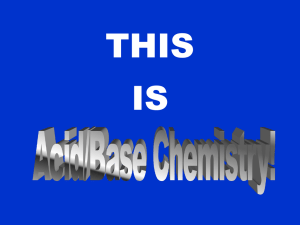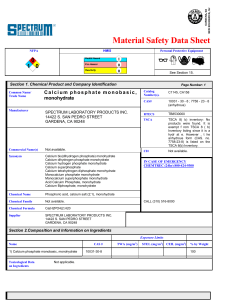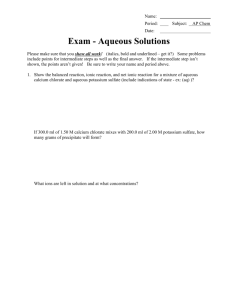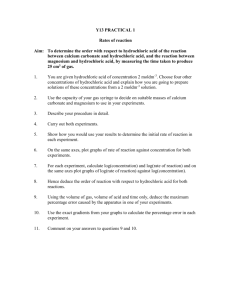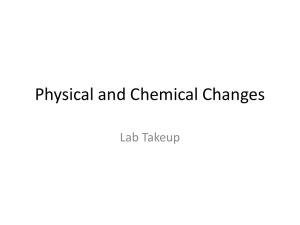Calcium Phosphate, Monobasic - The National Academies Press
advertisement
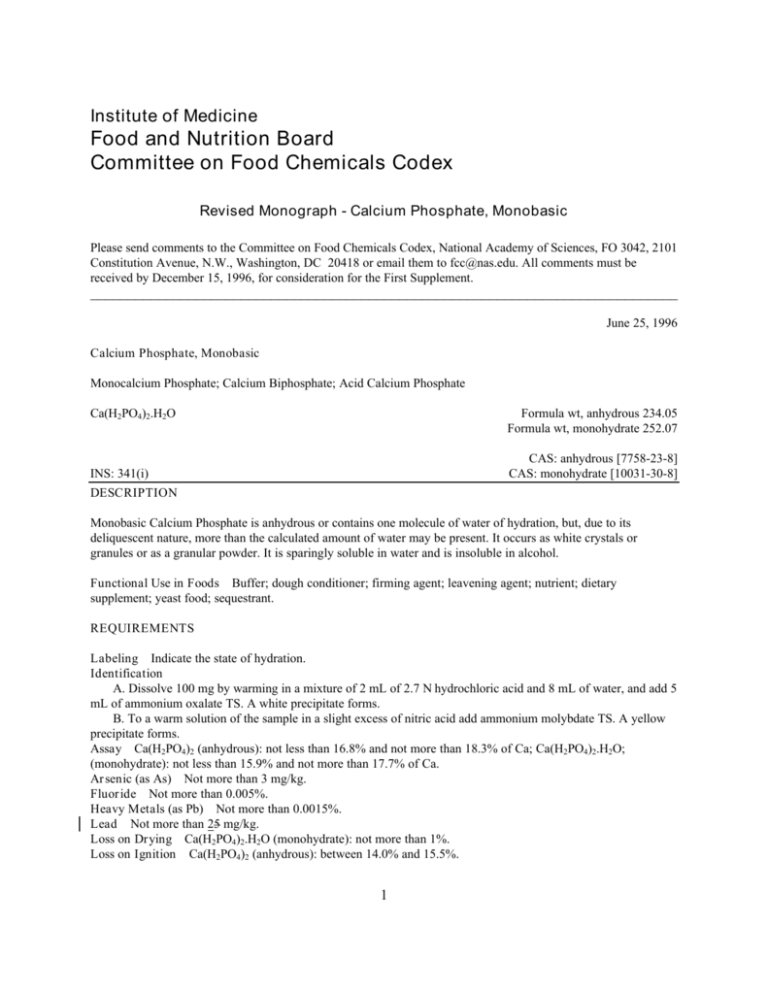
Institute of Medicine Food and Nutrition Board Committee on Food Chemicals Codex Revised Monograph - Calcium Phosphate, Monobasic Please send comments to the Committee on Food Chemicals Codex, National Academy of Sciences, FO 3042, 2101 Constitution Avenue, N.W., Washington, DC 20418 or email them to fcc@nas.edu. All comments must be received by December 15, 1996, for consideration for the First Supplement. ______________________________________________________________________________ June 25, 1996 Calcium Phosphate, Monobasic Monocalcium Phosphate; Calcium Biphosphate; Acid Calcium Phosphate Ca(H2PO4)2.H2O Formula wt, anhydrous 234.05 Formula wt, monohydrate 252.07 CAS: anhydrous [7758-23-8] CAS: monohydrate [10031-30-8] INS: 341(i) DESCRIPTION Monobasic Calcium Phosphate is anhydrous or contains one molecule of water of hydration, but, due to its deliquescent nature, more than the calculated amount of water may be present. It occurs as white crystals or granules or as a granular powder. It is sparingly soluble in water and is insoluble in alcohol. Functional Use in Foods Buffer; dough conditioner; firming agent; leavening agent; nutrient; dietary supplement; yeast food; sequestrant. REQUIREMENTS Labeling Indicate the state of hydration. Identification A. Dissolve 100 mg by warming in a mixture of 2 mL of 2.7 N hydrochloric acid and 8 mL of water, and add 5 mL of ammonium oxalate TS. A white precipitate forms. B. To a warm solution of the sample in a slight excess of nitric acid add ammonium molybdate TS. A yellow precipitate forms. Assay Ca(H2PO4)2 (anhydrous): not less than 16.8% and not more than 18.3% of Ca; Ca(H2PO4)2.H2O; (monohydrate): not less than 15.9% and not more than 17.7% of Ca. Arsenic (as As) Not more than 3 mg/kg. Fluoride Not more than 0.005%. Heavy Metals (as Pb) Not more than 0.0015%. Lead Not more than 25 mg/kg. Loss on Drying Ca(H2PO4)2.H2O (monohydrate): not more than 1%. Loss on Ignition Ca(H2PO4)2 (anhydrous): between 14.0% and 15.5%. 1 TESTS Assay Weigh accurately a portion of the sample equivalent to about 475 mg of Ca(H2PO4)2, dissolve it in 10 mL of 2.7 N hydrochloric acid, add a few drops of methyl orange TS, and boil for 5 min, keeping the volume and pH of the solution constant during the boiling period by adding hydrochloric acid or water, if necessary. Add 2 drops of methyl red TS and 30 mL of ammonium oxalate TS, then add dropwise, with constant stirring, a mixture of equal volumes of 6 N ammonium hydroxide and water until the pink color of the indicator just disappears. Digest on a steam bath for 30 min, cool to room temperature, allow the precipitate to settle, and filter the supernatant liquid through a sintered-glass crucible, using gentle suction. Wash the precipitate in the beaker with about 30 mL of cold (below 20°) wash solution, prepared by diluting 10 mL of ammonium oxalate TS to 1000 mL. Allow the precipitate to settle, and pour the supernatant liquid through the filter. Repeat this washing by decantation three more times. Using the wash solution, transfer the precipitate as completely as possible to the filter. Finally, wash the beaker and the filter with two 10-mL portions of cold (below 20°) water. Place the sintered-glass crucible in the beaker, and add 100 mL of water and 50 mL of cold dilute sulfuric acid (1 in 6). Add from a buret 35 mL of 0.1 N potassium permanganate, and stir until the color disappears. Heat to about 70°, and complete the titration with 0.1 N potassium permanganate. Each mL of 0.1 N potassium permanganate is equivalent to 2.004 mg of Ca. Arsenic A solution of 1 g in 5 mL of 2.7 N hydrochloric acid meets the requirements of the Arsenic Test, Appendix IIIB. Fluoride (anhydrous): determine as directed in Method II under the Fluoride Limit Test, Appendix IIIB; (monohydrate): proceed as directed under Fluoride in the monograph for Calcium Phosphate, Dibasic. Heavy Metals Warm 2.66 g with 5 mL of 2.7 N hydrochloric acid until no more dissolves, dilute to 50 mL with water, and filter. A 25-mL portion of the filtrate meets the requirements of the Heavy Metals Test, Appendix IIIB, using 20 µg of lead ion (Pb) in the control (Solution A). Lead A 10-g sample using a 5-µg/mL Standard Lead Solution meets the requirements of the APDC Extraction Method for Lead, Appendix IIIB. Loss on Drying, Appendix IIC Dry Ca(H2PO4)2.H2O (monohydrate) at 60° for 3 h. Loss on Ignition Weigh accurately about 3 g of Ca(H2PO4)2 (anhydrous), and ignite, preferably in a muffle furnace, at 800° for 30 min. Packaging and Storage Store in well-closed containers. 2

